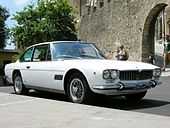Maserati Mexico
| Maserati Mexico | |
|---|---|
 | |
| Overview | |
| Manufacturer | Maserati |
| Production | 1966-1972 |
| Designer | Virginio Vairo of Vignale[1] |
| Body and chassis | |
| Class | Grand tourer |
| Body style | 2-door, 4-seater coupe |
| Layout | FR layout |
| Chassis | Welded tubular trellis |
| Related | Maserati Quattroporte |
| Powertrain | |
| Engine | 4.7 Liter (4.2 Liter) 90° V8 engine, four twin-choke 38 DCNL5 Weber carburetors |
| Transmission | 5-speed-and-reverse (automatic transmission an option), Rear-wheel drive |
| Dimensions | |
| Wheelbase | 2,640 mm (104 in) |
| Length | 4,760 mm (187 in) |
| Width | 1,730 mm (68 in) |
| Height | 1,340 mm (53 in) |
| Curb weight | 1,600 kg (3,500 lb) (dry) |
| Chronology | |
| Predecessor | Maserati 5000 GT |
The Vignale Maserati Mexico (Tipo 112) body was first used on a 5000GT chassis which an important Mexican customer had shipped to Italy for repair after crashing it. Thereafter the model became known as the Mexico. By coincidence, the Cooper-Maserati win in the Mexican Grand Prix occurred the following year. It made an appearance at the Vignale stand at the Salon di Torino in 1965 and was so well received that Maserati immediately made plans to put a version into limited production. A year later the production model debuted at the Paris Motor Show.
Originally powered by a 4.7 Liter V8 that produced 290 bhp, the car managed to turn out a top speed between 240–250 km/h (150-156 mph). In 1969, however, contrary to Maserati tradition, the Mexico was also made available with a 'smaller' engine. This time the 4.2-litre V8 engine that powered the original Quattroporte.
Apart from the smaller engine option the Mexico underwent few changes during its lifetime. Its luxurious interior included a rich leather seating for four adults, electric windows, wooden dashboard and air conditioning as standard. Automatic transmission, power steering and a radio were available as optional extras. The 4.7-litre version was fitted with 650 x 15" Borrani chrome wire wheels and the 4.2-litre version with 'disc' wheels. When leaving the factory all Maserati Mexicos originally fitted Pirelli Cinturato 205VR15 tyres (CN72).
The Mexico was the first production Maserati to be fitted with servo assisted ventilated disc brakes on all four wheels.
In May 1965, under commission from the German concessionaire Auto Koenig for their client, Herr Rupertzhoven, Maserati built a 'Mexico' similar to Vignale's original prototype design but was the work of Frua. Appearing like a 4-seat Mistral and built on the same tubular chassis as the 3500GT (2600 mm wheelbase), this prototype 'Mexico' was fitted with the Mistral's six-cylinder 3.7-litre Lucas fuel-injected engine. It was finished in Oro Longchamps with a black leather interior. Its dashboard came from the Quattroporte. 485 Mexicos were produced.
References
- ↑ "Maserati Mexico Registry". Maserati Mexico Registry. Retrieved 15 January 2014.
| ||||||||||||||||||||||||||||||||||
| Maserati road car timeline, 1950s–present | ||||||||||||||||||||||||||||||||||||||||||||||||||||||||||||||||||
|---|---|---|---|---|---|---|---|---|---|---|---|---|---|---|---|---|---|---|---|---|---|---|---|---|---|---|---|---|---|---|---|---|---|---|---|---|---|---|---|---|---|---|---|---|---|---|---|---|---|---|---|---|---|---|---|---|---|---|---|---|---|---|---|---|---|---|
| Type | 1950s | 1960s | 1970s | 1980s | 1990s | 2000s | 2010s | |||||||||||||||||||||||||||||||||||||||||||||||||||||||||||
| 0 | 1 | 2 | 3 | 4 | 5 | 6 | 7 | 8 | 9 | 0 | 1 | 2 | 3 | 4 | 5 | 6 | 7 | 8 | 9 | 0 | 1 | 2 | 3 | 4 | 5 | 6 | 7 | 8 | 9 | 0 | 1 | 2 | 3 | 4 | 5 | 6 | 7 | 8 | 9 | 0 | 1 | 2 | 3 | 4 | 5 | 6 | 7 | 8 | 9 | 0 | 1 | 2 | 3 | 4 | 5 | 6 | 7 | 8 | 9 | 0 | 1 | 2 | 3 | 4 | 5 | |
| Ownership | Orsi family | Citroën | De Tomaso | Fiat S.p.A. | ||||||||||||||||||||||||||||||||||||||||||||||||||||||||||||||
| Executive | Biturbo | Ghibli III | ||||||||||||||||||||||||||||||||||||||||||||||||||||||||||||||||
| Luxury | Quattroporte | QP II | Quattroporte III | QP IV | Quattroporte V | QP VI | ||||||||||||||||||||||||||||||||||||||||||||||||||||||||||||
| GT | A6 | 3500 GT | Sebring | 228 | Ghibli II | 3200GT | Coupé | |||||||||||||||||||||||||||||||||||||||||||||||||||||||||||
| 5000 GT | Ghibli | Khamsin | Shamal | GranTurismo | ||||||||||||||||||||||||||||||||||||||||||||||||||||||||||||||
| Mistral | Karif | |||||||||||||||||||||||||||||||||||||||||||||||||||||||||||||||||
| 2+2 | Mexico | Kyalami | ||||||||||||||||||||||||||||||||||||||||||||||||||||||||||||||||
| Indy | ||||||||||||||||||||||||||||||||||||||||||||||||||||||||||||||||||
| Mid-engine | Bora | |||||||||||||||||||||||||||||||||||||||||||||||||||||||||||||||||
| Merak | ||||||||||||||||||||||||||||||||||||||||||||||||||||||||||||||||||
| Supercar | MC12 | |||||||||||||||||||||||||||||||||||||||||||||||||||||||||||||||||
| SUV | Levante | |||||||||||||||||||||||||||||||||||||||||||||||||||||||||||||||||